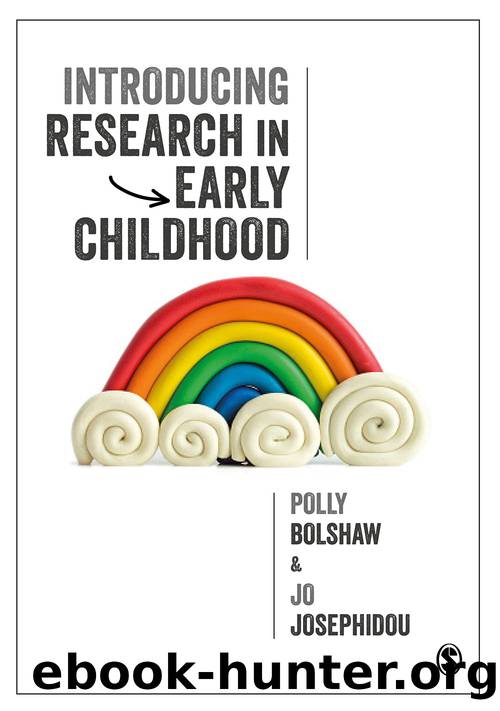Introducing Research in Early Childhood by Bolshaw Polly;Josephidou Jo; & Jo Josephidou

Author:Bolshaw, Polly;Josephidou, Jo; & Jo Josephidou
Language: eng
Format: epub
ISBN: 9781526451743
Publisher: SAGE Publications, Limited
Published: 2020-10-26T19:24:37.759811+00:00
Draw up a table of what you think are the advantages and the disadvantages of doing longitudinal research. Do you think the benefits outweigh the limitations? Why?
Case Study
Pooja: a community outreach officer in a childrenâs centre
Pooja works in a childrenâs centre as a community outreach officer. Part of her role involves supporting childrenâs home learning environments (HLE) by delivering the Bookstart Corner programme (Booktrust, 2017). She works with individual families who have a child aged between 12 and 30 months in their home to deliver four sessions that focus on books and rhymes. The families are given a small number of resources that promote stories and songs, like picture books, rhyme sheets, a finger puppet and an informational DVD for parents. She knows from her own professional experience that the programme can be effective in supporting the childrenâs HLE, for instance she has anecdotal evidence from parents that they have begun taking their child to the local library following their four sessions. She has also read research which shows the positive impact of the Bookstart Corner programme on childrenâs HLE. Families in one study reported that there was a significant increase in the number of books that the children owned and were bought following completion of the programme (Demack and Stevens, 2013). There was also an increase in the number of parents that read to their child every day. However, Pooja wants to know what longitudinal evidence exists that there are long-term benefits to a high-quality HLE for young children. She decides to look at two longitudinal pieces of research â the EPPE Project and the Millennium Cohort Study.
Firstly, she explores findings from the EPPE Project. She finds one peer-reviewed piece of research by Sammons et al. (2015) which says there are actually rather few studies that have assessed whether there is a link between high-quality HLE in the early years and academic outcomes when the child is older. However, the EPPE Project findings state that, even when childrenâs individual and family characteristics are considered, âthe early years HLE continues to predict studentsâ later educational success in secondary school demonstrating long-lasting positive effects on academic attainment at age 14 and 16â (Sammons et al., 2015: 194). Specifically, children in the highest HLE category in their earliest years had better grades in English, Maths and Science at age 14 than those in the lowest category, and at 16 they received better English and Maths GCSE results. The researchers suggest that there are implications for policy and practice, because it has been identified as worthwhile and beneficial to develop childrenâs HLE to improve their later educational outcomes. Pooja also reads Frank Fieldâs (2010) review of poverty and life chances in the UK, which draws on evidence from the EPPE Project to argue that a high quality HLE is a key driver of life chances throughout childhood. He thus recommends that increased funding should be offered to support good home learning environments as one way to attempt to break that cycle of poverty that currently exists for many families (Field, 2010: 7).
Download
This site does not store any files on its server. We only index and link to content provided by other sites. Please contact the content providers to delete copyright contents if any and email us, we'll remove relevant links or contents immediately.
Life in a Victorian School by Bob Mealing(156)
Math and Science Investigations by Sally Anderson(143)
Why Think? by Stanley Sara;(114)
Best Practices of Award-Winning Elementary School Principals by Harris Sandra K.;(99)
Introducing Research in Early Childhood by Bolshaw Polly;Josephidou Jo; & Jo Josephidou(96)
Wrestling with Writing by Nicholas D. Young & Bryan Thors Noonan & Kristen Bonanno-Sotiropoulos(91)
Loving Math by Unknown(89)
Transform Your K-5 Math Class by Amanda Thomas(84)
The Last Little Book About Big Words by James Roberts (Gentleman Jim)(76)
Brain-Friendly Study Strategies, Grades 2-8 by Schwed Amy J.;Melichar-Utter Janice;(71)
What If Your ABCs Were Your 123s? by Leslie Minton(68)
Brain-Compatible Activities for Mathematics, Grades 4-5 by Sousa David A.;(68)
Provoking Curiosity by Angela Eckhoff(63)
Help! for Teachers of Young Children by Kaltman Gwendolyn S.;(61)
Nonfiction Notebooks : Strategies for Informational Writing by Aimee Buckner(60)
Making Music in the Primary School by Beach Nick;Evans Julie;Spruce Gary;(59)
Art in the Early Years by Eglinton Kristen Ali;(58)
Strategies to Integrate the Arts in Mathematics by Linda Dacey; Lisa Donovan(58)
A Chance for Change by Crystal R. Sanders(53)
